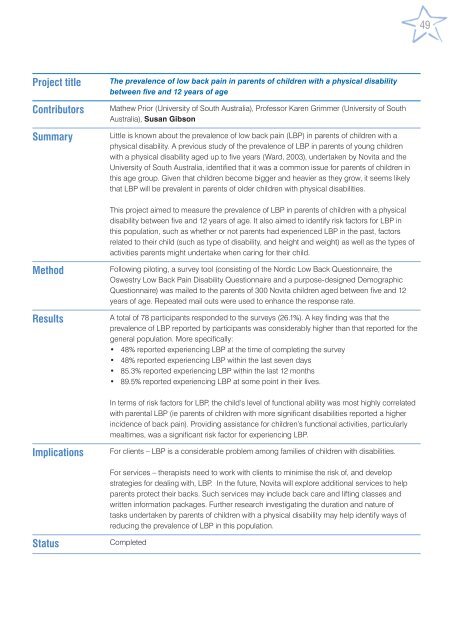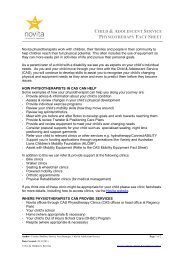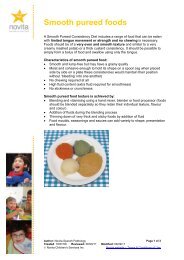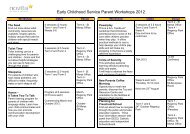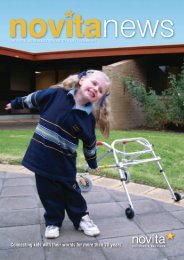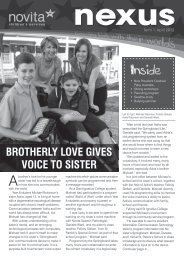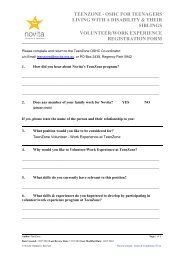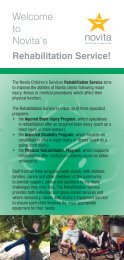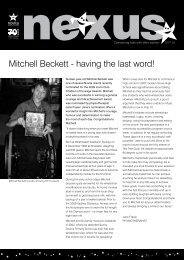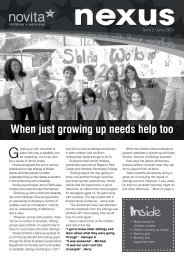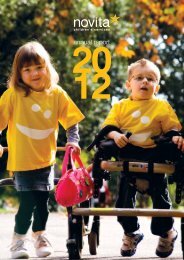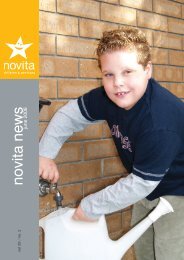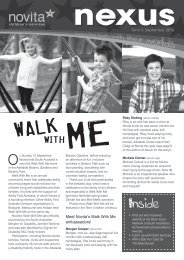Novita Research Report - 2004 to 2007 - Novita Children's Services
Novita Research Report - 2004 to 2007 - Novita Children's Services
Novita Research Report - 2004 to 2007 - Novita Children's Services
- No tags were found...
Create successful ePaper yourself
Turn your PDF publications into a flip-book with our unique Google optimized e-Paper software.
49Project titleContribu<strong>to</strong>rsSummaryThe prevalence of low back pain in parents of children with a physical disabilitybetween five and 12 years of ageMathew Prior (University of South Australia), Professor Karen Grimmer (University of SouthAustralia), Susan GibsonLittle is known about the prevalence of low back pain (LBP) in parents of children with aphysical disability. A previous study of the prevalence of LBP in parents of young childrenwith a physical disability aged up <strong>to</strong> five years (Ward, 2003), undertaken by <strong>Novita</strong> and theUniversity of South Australia, identified that it was a common issue for parents of children inthis age group. Given that children become bigger and heavier as they grow, it seems likelythat LBP will be prevalent in parents of older children with physical disabilities.This project aimed <strong>to</strong> measure the prevalence of LBP in parents of children with a physicaldisability between five and 12 years of age. It also aimed <strong>to</strong> identify risk fac<strong>to</strong>rs for LBP inthis population, such as whether or not parents had experienced LBP in the past, fac<strong>to</strong>rsrelated <strong>to</strong> their child (such as type of disability, and height and weight) as well as the types ofactivities parents might undertake when caring for their child.MethodResultsFollowing piloting, a survey <strong>to</strong>ol (consisting of the Nordic Low Back Questionnaire, theOswestry Low Back Pain Disability Questionnaire and a purpose-designed DemographicQuestionnaire) was mailed <strong>to</strong> the parents of 300 <strong>Novita</strong> children aged between five and 12years of age. Repeated mail outs were used <strong>to</strong> enhance the response rate.A <strong>to</strong>tal of 78 participants responded <strong>to</strong> the surveys (26.1%). A key finding was that theprevalence of LBP reported by participants was considerably higher than that reported for thegeneral population. More specifically:• 48% reported experiencing LBP at the time of completing the survey• 48% reported experiencing LBP within the last seven days• 85.3% reported experiencing LBP within the last 12 months• 89.5% reported experiencing LBP at some point in their lives.In terms of risk fac<strong>to</strong>rs for LBP, the child’s level of functional ability was most highly correlatedwith parental LBP (ie parents of children with more significant disabilities reported a higherincidence of back pain). Providing assistance for children’s functional activities, particularlymealtimes, was a significant risk fac<strong>to</strong>r for experiencing LBP.ImplicationsFor clients – LBP is a considerable problem among families of children with disabilities.For services – therapists need <strong>to</strong> work with clients <strong>to</strong> minimise the risk of, and developstrategies for dealing with, LBP. In the future, <strong>Novita</strong> will explore additional services <strong>to</strong> helpparents protect their backs. Such services may include back care and lifting classes andwritten information packages. Further research investigating the duration and nature oftasks undertaken by parents of children with a physical disability may help identify ways ofreducing the prevalence of LBP in this population.StatusCompleted


